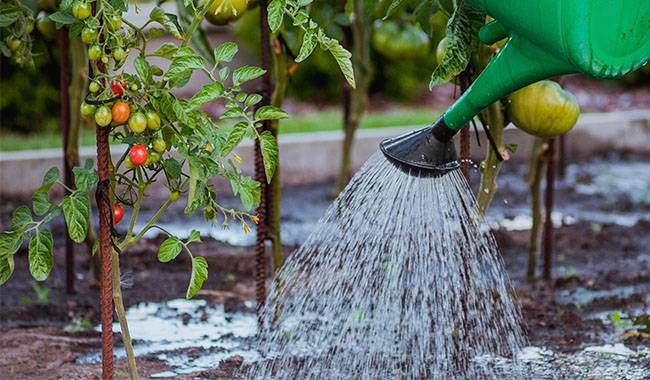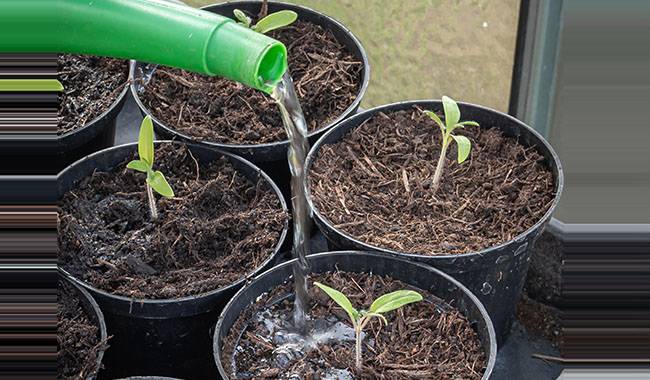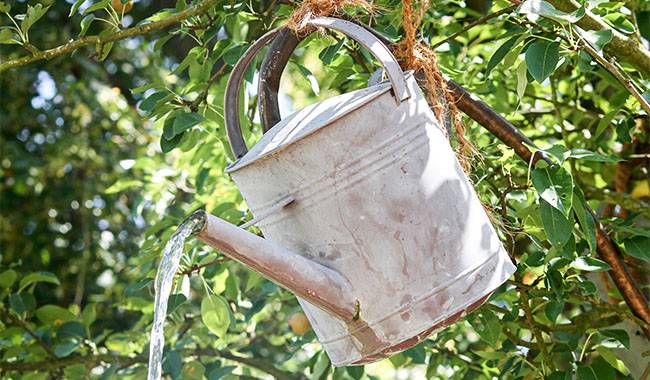
Without water, the plant would not be live. Thanks to moisture, they can feed themselves by absorbing substances dissolved in the soil by their roots, and they also use pure water in its form.
Only sufficient water in the soil can promote the achievement of high yields, provide normal vital functions for plants, prolong flowering, etc.
However, for the vast majority of plants, too much water in the soil and air, as well as too much fertilizer, can lead to negative consequences until an outbreak of fungal infection or root rot, which can lead to plant death.
We will talk about the main mistakes when watering the garden, the time and speed of watering for different crops in the article.
Watering in hot weather
Never water any vegetable plants in the heat of summer. The only exceptions are plants in the shade, but usually, there are only a few in the garden.
When watering in hot weather, first, water evaporates from the soil surface fairly quickly, and second, no matter how carefully you water, small droplets of water will fall on the leaves, and under the influence of the sun, these droplets literally boil on the leaves, creating burns. These burns are an open portal for infection to enter.
Cold (ice) water
Often, gardens are watered entirely from a hose, in which case the water becomes very cold a few seconds after being poured.
This can be a real shock to plants, but “thick-skinned” trees and shrubs can tolerate it, while sensitive vegetables may even curl their leaves like a light frost. Try to water your garden with water heated to room temperature – not hot water, of course.
There is nothing difficult about it: you can install a large bucket (or several) on the plot, at least 20inch (0.5m) above sea level, paint it (them) black, connect the hose to the tap and fill the bucket with water. Within a day, the water will heat up and you will be able to water it at night.
In addition, you will get even and steady water, and if the bucket is placed under the sink and the garbage from the roof and the covered mesh is not obtained, then the rainwater obtained, perfectly suitable for watering the garden (aerated), is even free!
Powerful spraying
Another mistake: the gardener not only waters the garden with a hose but also makes a strong spray. Some people explain this by the fact that the water penetrates the soil faster and does not spread on the surface. But watering in this way does more harm than good.
Water under pressure can strongly erode the soil, exposing the roots. Later, if they are not covered by soil, they will dry out and the plant will suffer (or even die).
The best way to water with a hose is to let the water flow without pressure, then the roots will not be washed away.
Watering the leaves untimely
In fact, it is best not to over-water in this way and to water only according to the weather. For example, if the weather is moderately humid and the sky is cloudy, it is better not to water on the leaves of the plant, but if it is hot during the day, you can sprinkle water in the morning.
By the way, early morning watering is better than evening watering. If you sprinkle at night, the water will stay on the leaves for a long time, creating the most favorable environment for the development of fungal infections.
If you water in the morning, water only a little earlier, around 4:00 a.m. Then as the sun rises and the air warms up, the water will slowly evaporate and will not cause any damage to the leaf discs.
Watering through the crust on the soil
Before you start watering your vegetable garden, if you have not watered for a few days and a crust has formed on the surface of the soil, you must make sure you break it with the tip of your hoe. If you do not do this, the water will not be absorbed into the soil immediately and a considerable amount of water will spread on its surface.
This will, firstly, lead to a significant loss of water and, secondly, may cause over-watering of the soil in the depressions and under watering in other places.
Insufficient or excessive supply of water
As we have written repeatedly, everything needs a specification. Too little or too much watering can cause insufficient water and mediocre droughts that starve the plants or, on the contrary, too much water and root rot and outbreaks of fungal diseases.
It is necessary to water the garden so that the soil is soaked at least 4-6inch (10-15 cm) – this is the area where the roots of most vegetable crops are located.
Depending on the type of soil, one to three buckets per square meter should be watered. Obviously, the looser the soil, the less water is needed at a time, but the more water evaporates from the soil, so the watering itself should be more frequent (and vice versa).
Heavy watering with long intervals
This can often be seen in the plots in Dashain. We come in once a week during the summer, generously water the entire garden, turn it into a swamp, and then leave it for a week, leaving it completely without water for that period of time.
The moisture is literally spent on food and evaporates away the next day or twenty-four hours later, and four or five days later the garden is dry.
This is bad and causes the plant to literally go into shock: then there is a lot of nutrients and water, and then no it at all; as a result, the plant immunity decreases, diseases break out, poor quality fruit is formed, etc.
Such watering is generally dangerous during the ripening period of fruits: deciding to water heavily after a long drought, a lot of water enters the fruits and makes them crack. To avoid all these phenomena, it is better to use drip irrigation.
It is simple and effective – take a bucket, raise it 20inch (0.5m) on a brick, insert the dripper (pipe with holes), pour the water into the bucket, place the dripper around the vegetable garden and bring it to the plants.
After that, you can safely go home. One hundred-liter bucket of water is likely to be enough for a week for a six-acre vegetable garden, and the watering will be even and complete.
You can water the garden gradually over the weekend, a little in the morning and a little in the evening so that the water will be absorbed evenly by the soil.
Watering without mulch
Gardeners often water in the morning and forget about the vegetable garden. In the morning, water begins to evaporate aggressively and plants can experience a real drought before the next watering. In order to fully saturate the soil with water, we recommend watering in the late afternoon and putting mulch on the soil surface afterward.
A 0.4inch (1cm) thick layer of humus, or if not available, regular soil that is just dry, can be used as a mulch. Such a layer of mulch prevents water from evaporating and stays on the roots longer, and the plants do not lack water until the next watering.
No watering after fertilizer application
After applying mineral fertilizer or grass ash in a dry state, be sure to water the soil so that its components do not evaporate during the day and can penetrate quickly into the soil.
The best way to do this is to loosen the soil, then water it with moistening, then apply the fertilizer, watering a few more liters of water under each plant, and finally cover the fertilizer with soil to embed it in the moist soil.
Watering without observing the time and norms
Gardeners often make this mistake through ignorance, watering all vegetable crops in the same way and when they (gardeners) want to.
To fill in the gaps in knowledge about irrigation, we have compiled a table with details of the watering times and rates for the most common vegetable crops.

Irrigation time and rate for different crops
Early cabbage
The capacity of the root system: medium.
Watering period: May to July.
Watering frequency: 5 times.
Time of watering: at planting, three days later, then – one week later, depending on the availability of precipitation.
Irrigation rate (l/m2): 30-32.
Water consumption per kg of harvest (liters): 9.
Late cabbage
The capacity of the root system: medium.
Watering period: May-August.
Watering frequency: 10 times.
Timing of watering: first watering when planting seedlings on the plot, second watering a week after the first watering, third to fifth watering – during rosette leaf formation, sixth to eighth watering – during cabbage booking, ninth and tenth watering – during technical maturity of cabbage.
Irrigation rate (l/m2): 35-45.
Water consumption per kg of harvest (liters): 11.
Early cucumber
The capacity of the root system: strong and forked.
Watering period: May-August.
Watering frequency: 7 times.
Timing of watering: first watering – at the formation of two to three true leaves, second and third watering – at the germination stage, at one-week intervals, fourth and fifth – at the flowering stage, at five days intervals, sixth and seventh – at the fruiting stage, at six days intervals.
Irrigation rate (l/m2): 25-30.
Water consumption per kg of harvest (liters): 12.
Late cucumber
The capacity of the root system: strong and much-branched.
Watering period: May to September.
Watering frequency: 9 times.
Watering time: first watering – during the formation of two or three leaves, second and third watering – during the germination stage, at 5 days intervals, fourth and fifth watering – during flowering, at 4 days intervals, from the sixth to the ninth – during the fruiting stage, at 5 days intervals, depending on the availability of precipitation.
Irrigation rate (l/m2): 25-35.
Water consumption per kg of harvest (liters): 15.
Onion (seeds into the soil)
The capacity of the root system: weak.
Watering period: May-August.
Watering frequency: 9 times.
Timing of watering: first – at the first thinning (thinning), second watering – after a week, third watering – at the second thinning, from the fourth to the ninth – during the growth of the bulb, with an interval of five days, depending on the availability of precipitation.
Irrigation rate (l/m2): 25-35.
Water consumption per kg of harvest (liters): 13.
Tomato sprouts
The capacity of the root system: strong.
Watering period: June to August.
Watering frequency: 8 times.
Timing of watering: the first watering should be done when planting seedlings, the second – at the stage of germination, the third and fourth – at the flowering stage with an interval of three days, the fifth – at the beginning of fruit formation, from the sixth to the eighth – at the beginning of ripening and collection of fruits with an interval of three or four days, depending on the availability of precipitation.
Irrigation rate (l/m2): 35-40.
Water consumption per kg of harvest (liters): 14.
Tomatoes without seedlings
The capacity of the root system: strong.
Watering period: May-August.
Watering frequency: 7 times.
Watering time: first watering – after weeding (thinning), second – during germination, third and fourth – during flowering with an interval of three days, fifth – during fruit formation, sixth and seventh – during the beginning of ripening and the beginning of fruit picking.
Irrigation rate (l/m2): 30-35.
Water consumption per kg of harvest (l): 12.

Pepper
The capacity of the root system: medium.
Watering period: May to September.
Watering frequency: 10 times.
Watering time: first watering – when planting seedlings, second watering – at the germination stage, third to fifth watering – during flowering, at an interval of four days, sixth and seventh watering – during fruit formation, at an interval of one week, eighth to tenth watering – during fruiting, at an interval of three days.
Irrigation rate (l/m2): 30-35.
Water consumption per kg of harvest (liters): 20.
Eggplant
The capacity of the root system: strong and much-branched.
Watering period: May to September.
Watering frequency: 10 times.
Watering time: first watering – when planting seedlings, second watering – at the germination stage, third to fifth watering – during flowering, at an interval of five days, sixth and seventh watering – during fruit formation, at an interval of one week, eighth to tenth – during fruiting, at an interval of four days.
Irrigation rate (l/m2): 35-40.
Water consumption per kg of harvest (liters): 22.
Carrot
The capacity of the root system: strong.
Watering period: May to September.
Watering frequency: 5 times.
Timing of watering: the first watering is related to the period after weeding (thinning), from the second to the fifth – during the formation and growth of root crops, with an interval of 5 days, depending on the availability of precipitation.
Irrigation rate (l/m2): 30.
Water consumption per kg of harvest (liters): 8.
Sugar beet
The capacity of the root system: weak.
Watering period: May-August.
Frequency of watering: 5 times.
Timing of watering: the first watering is related to the post-thinning period, from the second to the fifth – during the formation and growth of root crops, with an interval of four days, depending on the availability of precipitation.
Irrigation rate (l/m2): 35.
Water consumption per kg of harvest (liters): 9.
Planting potatoes in spring
The capacity of the root system: weak.
Watering period: May to September.
Watering frequency: 4 times.
Timing of watering: first watering – at the germination stage, second – at the flowering stage, third and fourth – at the tuber formation stage, at intervals of one week, depending on the availability of precipitation.
Irrigation rate (l/m2): 35-40.
Water consumption per kg of harvest (liters): 8.
Potatoes grown in summer
The capacity of the root system: weak.
Watering period: May to September.
Watering frequency: 6 times.
Timing of water: first, second and third – after germination, at an interval of four days, fourth – at the germination stage, fifth and sixth – at the tuber formation stage, at an interval of one week, depending on the availability of precipitation.
Irrigation rate (l/m2): 40-45.
Water consumption per kg of harvest (liters): 10.
Of course, you should always consider the weather. For example, if there is heavy rain and you are about to water the plants, you do not have to water them; on the other hand, if it rains quickly and lightly, you will have to water them because this rain will only soak the topsoil and the soil at the roots will remain dry.
CONCLUSION
Here are all the mistakes that we want to tell you when watering your vegetable garden. If you still have questions, then ask them in the comments and we will be sure to answer them.
If you know of any other watering mistakes, please write them in the comments, it would be very useful for our readers.







